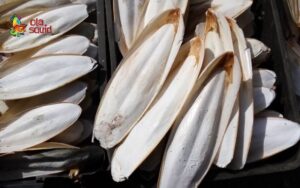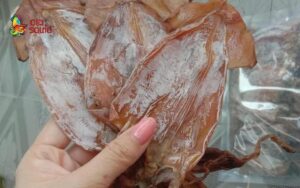Dried squid is a popular seafood specialty known for its rich flavor, ease of preparation, and long shelf life. However, many people encounter the problem of **moldy dried squid** during storage. The following article will help you understand the causes, how to identify, and what to do when you encounter this issue, as well as provide guidance on proper storage to keep dried squid fresh and safe.
1. Causes of Moldy Dried Squid
The appearance of mold on dried squid is usually due to inadequate storage conditions. Some common causes include:
- High humidity: Vietnam’s tropical monsoon climate, characterized by high air humidity year-round, is a major factor that causes dried squid to mold easily, even during transportation or storage at the shop. If stored in a humid environment, the squid will absorb moisture and become moldy.
- Not sealed properly: If dried squid is stored in a humid environment without proper sealing, it can easily come into contact with the air, leading to mold. Even if it is sealed, storing it near a stove, a humid refrigerator, or in a poorly ventilated space can still cause mold to develop.

- Over-storage: Although it’s a dried food, dried squid still has an expiration date. If left for too long without consumption, the oil in the squid can oxidize, reducing its quality and leading to mold.
- Purchasing low-quality dried squid: Many squid products are produced long ago, fail to meet drying standards, or are not vacuum-sealed properly, making them prone to spoilage. Old or unorigin-verified squid tends to mold faster even when stored correctly.
2. Signs of Moldy Dried Squid
Identifying moldy dried squid is not difficult; a close inspection before use will make it easy to detect. Here are some characteristic signs:
- Mold spots on the surface: When dried squid becomes moldy, small blackish-green spots often appear on its body or tentacles. For squid that has just started to mold, check the tentacles, head, and flip it over, as the mold spots at this stage are very small and faint, making them hard to detect.
- Unusual white coating: Quality dried squid usually has a thin, dry white powdery coating that is light and easily blown away. Conversely, moldy squid will have a thick, moist, and sticky white layer. It feels slightly wet to the touch and cannot be blown away.
- Foul or strange smell: Normal dried squid has a pleasant, slightly oceanic aroma. If you detect a pungent, strong, or unpleasant moldy smell, it’s likely that the squid has been contaminated with mold.
- Altered taste: Moldy squid often loses its natural sweetness, becoming bitter, fishy, or slightly astringent, making dishes less delicious and difficult to enjoy.
See more: Does dried squid with white powder taste good?
3. Is Moldy Dried Squid Edible?
It is best not to consume moldy dried squid, especially if the mold has spread widely or is clearly green or black. Although dried squid is a high-value food, consuming mold-infected products can pose significant health risks.

In a moldy environment, various fungi produce enzymes and toxins that can cause digestive disorders and even acute poisoning if consumed. More concerningly, mold on dried seafood can produce aflatoxins – toxins scientifically proven to be linked to liver cancer.
4. How to Deal with Lightly Moldy Dried Squid
If the dried squid has only minor mold, with a few scattered small green-black spots, you can still process it for consumption. However, it is important to note that simply washing or sun-drying is not enough, as the toxins secreted by the mold, especially aflatoxins, are highly heat-resistant and cannot be destroyed by ordinary temperatures.
Follow these steps for proper treatment:
- Step 1: Use a sharp knife to deeply cut away the entire moldy area, ensuring that the mold roots that have penetrated inside are also removed.
- Step 2: Soak the squid in warm water around 60°C for 20-30 minutes, or use diluted vinegar to clean the surface and disinfect.
- Step 3: After treatment, do not continue to store it. It should be processed immediately to prevent mold from returning or to avoid potential health risks.
See more: How to distinguish real from fake dried squid simply
5. How to Store Dried Squid to Prevent Mold
To keep dried squid fresh and mold-free, pay attention to how you store it after purchase or when you have leftovers. Here are some simple yet effective methods you can refer to:
- Refrigerate: The best way is to wrap the squid in white paper or clean newspaper, then place it in a sealed plastic bag and store it in the freezer compartment of your refrigerator. This method helps the squid retain its chewy texture, prevents it from becoming too dry, and can be safely stored for up to 6 months without worrying about mold.

- Store at room temperature: If you don’t have a refrigerator, you can refer to Ola Squid’s method for storing dried squid by wrapping it tightly in a sealed plastic bag, storing it in a cool, dry place away from direct sunlight and high humidity. Every 2-3 days, you should take the squid out to sun-dry it lightly for about 10-15 minutes to keep it dry and limit mold growth.
Moldy dried squid not only reduces the quality of dishes but also poses significant health risks if not handled properly. Early detection, timely treatment, or discarding when necessary is crucial. For more useful information or to explore dried squid products, please visit the **Ola Squid** website today!


 Tiếng Việt
Tiếng Việt ไทย
ไทย




